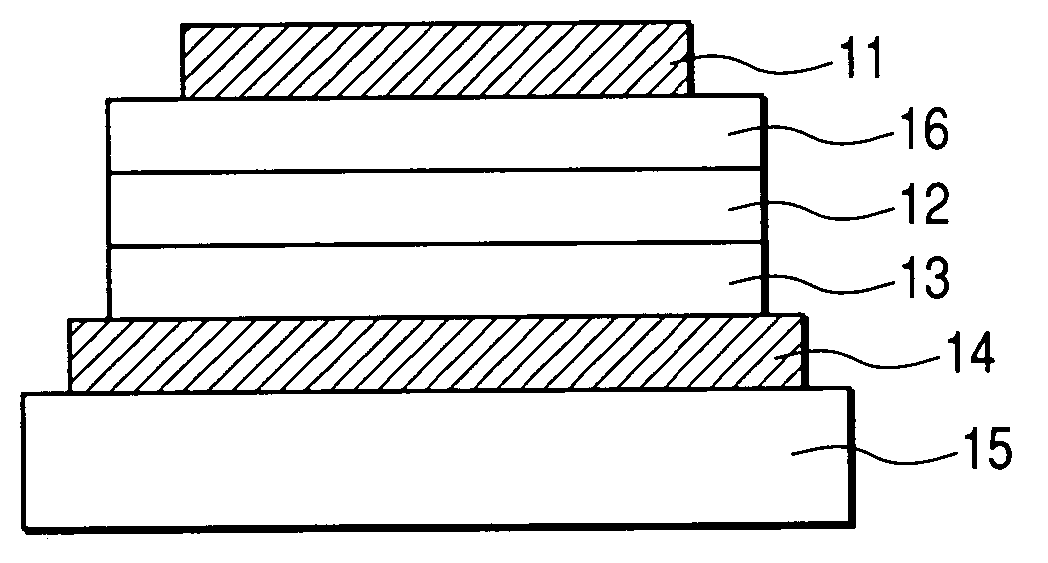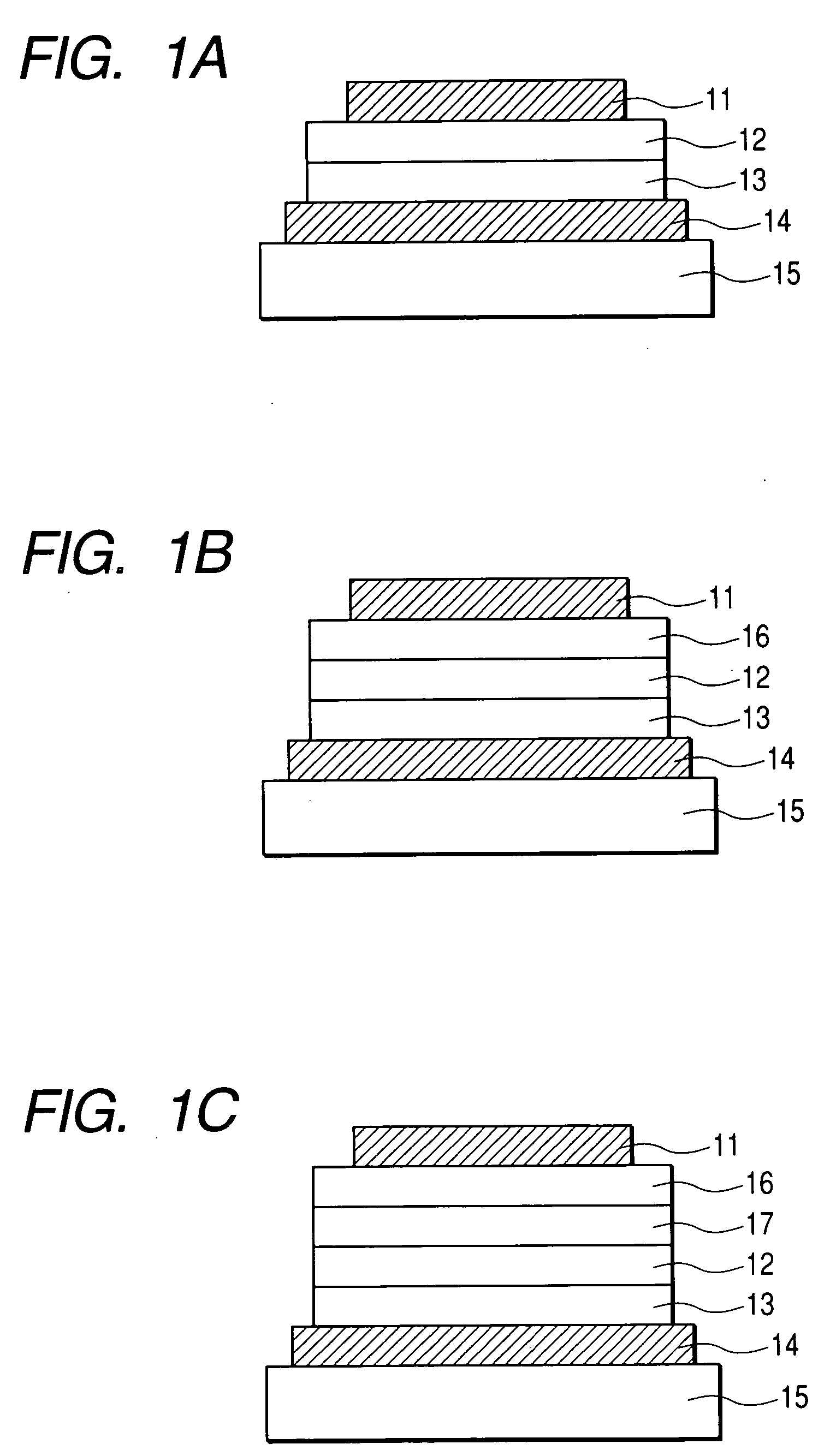Compound and organic electroluminescense device using the same
a technology of electroluminescent devices and compounds, which is applied in the direction of discharge tube luminescnet screens, natural mineral layered products, etc., can solve the problems of insufficient solution, insufficient and it is difficult to say that a compound sufficiently satisfying light emission luminance and durability has already been obtained, etc., to achieve high efficiency, high glass transition temperature, and high luminance
- Summary
- Abstract
- Description
- Claims
- Application Information
AI Technical Summary
Benefits of technology
Problems solved by technology
Method used
Image
Examples
example 1
Synthesis of Exemplified Compound No. H-52
[0049]
[0050] 512 mg (1 mmole) of a compound A, 165 mg (0.5 mmole) of 1,4-diiodobenzene, 0.1 g of Pd(PPh3)4, 10 ml of toluene, 5 ml of ethanol, and 10 ml of a 2-M aqueous solution of sodium carbonate were fed into a 100-ml round-bottomed flask, and the whole was stirred for 8 hours at 80° C. in a stream of nitrogen. After the completion of the reaction, the crystal was filtered out and washed with water, ethanol, and toluene. The resultant crystal was dried in a vacuum at 120° C., and was then subjected to sublimation purification to yield 200 mg of Exemplified Compound No. H-52 (47.2% yield).
[0051] 846.2 as M+ of the compound was observed by means of matrix assisted laser desorption / ionization-time of flight mass spectrometry (MALDI-TOF MS).
[0052] In addition, the structure of the compound was identified by NMR measurement.
[0053]1H NMR (CDCl3, 400 MHz) σ (ppm): 7.65-7.83 (m, 22H), 7.47 (m, 2H), 7.30-7.37 (m, 4H), 1.68 (s, 12H), 1.60 (s, 1...
example 2
[0054] In this example, a device having three organic layers shown in FIG. 1B was used as a device structure.
[0055] ITO (as the transparent electrode 14) having a thickness of 100 nm was patterned on a glass substrate (as the transparent substrate 15). The following organic layers and electrode layers were continuously formed on the ITO substrate by means of vacuum vapor deposition according to resistance heating in a vacuum chamber having a pressure of 10−5 Pa, to have an opposing electrode area of 3 mm2. Hole transport layer 13 (20 nm): compound B Light emission layer 12 (50 nm): Exemplified Compound No. H-52: Ir(piq)3 (10% in weight ratio) Electron transport layer 16 (30 nm): Bphen (manufactured by Dojin Laboratories) Metal electrode layer 1 (1 nm): KF Metal electrode layer 2 (100 nm): Al
[0056] The current-voltage characteristics of the EL device were measured by using a microammeter 4140B manufactured by Hewlett-Packard Development Company, and the light emission luminance the...
example 3
Synthesis of Exemplified Compound No. H-47
[0058]
[0059] 476 mg (2 mmole) of 2-(9,9-dimethyl)-fluorene boric acid, 406 mg (1 mmole) of 4,4′-diiodobiphenyl, 0.2 g of Pd(PPh3)4, 12 ml of toluene, 6 ml of ethanol, and 12 ml of a 2-M aqueous solution of sodium carbonate were fed into a 100-ml round-bottomed flask, and the whole was stirred for 8 hours at 80° C. in a stream of nitrogen. After the completion of the reaction, the reaction solution was extracted with toluene. The organic layer was washed with water and dried with magnesium sulfate, followed by evaporation to dryness under reduced pressure. The resultant was purified by means of silica gel column chromatography (eluent: hexane / toluene=10 / 1), followed by recrystallization with toluene / hexane. The resultant crystal was dried in a vacuum at 120° C., and was then subjected to sublimation purification to yield 377 mg of Exemplified Compound No. H-47 (70.0% yield).
[0060] 538.3 as M+ of the compound was observed by means of matrix a...
PUM
| Property | Measurement | Unit |
|---|---|---|
| Speed | aaaaa | aaaaa |
| Speed | aaaaa | aaaaa |
| Luminous efficiency | aaaaa | aaaaa |
Abstract
Description
Claims
Application Information
 Login to View More
Login to View More - R&D
- Intellectual Property
- Life Sciences
- Materials
- Tech Scout
- Unparalleled Data Quality
- Higher Quality Content
- 60% Fewer Hallucinations
Browse by: Latest US Patents, China's latest patents, Technical Efficacy Thesaurus, Application Domain, Technology Topic, Popular Technical Reports.
© 2025 PatSnap. All rights reserved.Legal|Privacy policy|Modern Slavery Act Transparency Statement|Sitemap|About US| Contact US: help@patsnap.com



